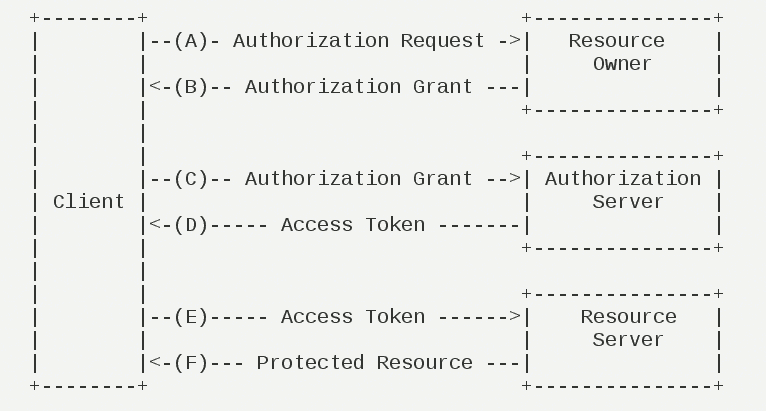spring-cloud-oauth2实现用户认证及单点登录
点击上方蓝色字体,选择“标星公众号”
优质文章,第一时间送达
作者 | 工程师小哥
来源 | urlify.cn/mI3qEz
需求
在微服务架构中,我们有很多业务模块,每个模块都需要有用户认证,权限校验。有时候也会接入来自第三方厂商的应用。要求是只登录一次,即可在各个服务的授权范围内进行操作。看到这个需求,立马就想到了这不就是单点登录吗?于是基于这样的需求,作者使用spring-cloud-oauth2去简单的实现了下用户认证和单点登录。
相关介绍
OAuth2
OAuth2是一个关于授权的网络标准,他定制了设计思路和执行流程。OAuth2一共有四种授权模式:授权码模式(authorization code)、简化模式(implicit)、密码模式(resource owner password)和客户端模式(client credentials)。数据的所有者告诉系统同意授权第三方应用进入系统,获取这些数据。于是数据所有者生产了一个短时间内有效的授权码(token)给第三方应用,用来代替密码,供第三方使用。具体流程请看下图,具体的OAuth2介绍,可以参考这篇文章,写的很详细。(http://www.ruanyifeng.com/blog/2019/04/oauth_design.html)

Token
令牌(token)和密码(password)的作用是一样的,都可以进入系统获取资源,但是也有几点不同:
令牌是短期的,到期会自动失效,用户无法修改。密码是长期的,用户可以修改,如果不修改,就不会发生变化。
令牌可以被数据所有者撤销,令牌会立即失效。密码一般不允许其他人撤销,只能被操作权限更高的人或者本人修改/重制。
令牌是有权限范围的,会被数据所有者授予。
实现的功能
本篇介绍的是通过密码模式来实现单点登录的功能。
在微服务架构中,我们的一个应用可能会有很多个服务运行,协调来处理实际的业务。这就需要用到单点登录的技术,来统一认证调取接口的是哪个用户。那总不能请求一次,就认证一次,这么做肯定是不行的。那么就需要在认证完用户之后,给这个用户授权,然后发一个令牌(token),有效期内用户请求资源时,就只需要带上这个标识自己身份的token即可。
架构说明
认证中心:oauth2-oauth-server,OAuth2的服务端,主要完成用户Token的生成、刷新、验证等。
微服务:mzh-etl,微服务之一,接收到请求之后回到认证中心(oauth2-oauth-server)去验证。
代码实现
使用到的框架是java基础的spring boot 和spring-cloud-oauth2
认证中心:
1、引入需要的maven包
org.springframework.boot
spring-boot-starter-web
org.springframework.cloud
spring-cloud-starter-oauth2
org.springframework.boot
spring-boot-starter-data-redis
org.springframework.boot
spring-boot-starter-actuator
因为spring-cloud-starter-oauth2中包含了spring-cloud-starter-security,所以就不用再单独引入了,引入redis包是为了使用redis来存储token。
2、配置application.yml
这里主要用到的是redis的配置,mysql数据库的配置暂时没有用到。
spring:
application:
name: oauth-server
datasource:
url: jdbc:mysql://localhost:3306/mzh_oauth?useSSL=false&characterEncoding=UTF-8
username: root
password: admin123
driver-class-name: com.mysql.jdbc.Driver
hikari:
connection-timeout: 30000
idle-timeout: 600000
max-lifetime: 1800000
maximum-pool-size: 9
redis:
database: 0
host: localhost
port: 6379
jedis:
pool:
max-active: 8
max-idle: 8
min-idle: 0
timeout: 10000
server:
port: 8888
use-forward-headers: true
management:
endpoint:
health:
enabled: true
3、spring security 权限配置
需要继承WebSecurityConfigurerAdapter
/**
* @Author mzh
* @Date 2020/10/24
*/
@Configuration
@EnableWebSecurity
@EnableGlobalMethodSecurity(prePostEnabled = true)
public class WebSecurityConfig extends WebSecurityConfigurerAdapter {
@Autowired
private CustomUserDetailsService customUserDetailsService;
/**
* 修改密码的加密方式
* @return
*/
@Bean
public PasswordEncoder passwordEncoder(){
return new BCryptPasswordEncoder();
}
@Bean
@Override
public AuthenticationManager authenticationManagerBean() throws Exception{
return super.authenticationManagerBean();
}
@Override
protected void configure(AuthenticationManagerBuilder auth) throws Exception{
// 如果使用BCryptPasswordEncoder,这里就必须指定密码的加密类
auth.userDetailsService(customUserDetailsService).passwordEncoder(passwordEncoder());
}
@Override
protected void configure(HttpSecurity http) throws Exception {
http.authorizeRequests()
.antMatchers("/oauth/**").permitAll();
}
}
BCryptPasswordEncoder是一个不可逆的密码加密类,AuthenticationManager是OAuth2的password必须指定的授权管理Bean。
CustomUserDetailsService这个类是被注入进来的,熟悉spring security的同学应该知道,spring security有一个自己的UserdetailsService用于权限校验时获取用户信息,但是很多时候不符合我们的业务场景,就需要重现实现这个类。
4、实现CustomUserDetailsService
UserDetailsService这个类的核心方法就是loadUserByUsername()方法,他接收一个用户名,返回一个UserDetails对象。
/**
* @Author mzh
* @Date 2020/10/24
*/
@Component(value = "customUserDetailsService")
public class CustomUserDetailsService implements UserDetailsService {
@Autowired
private PasswordEncoder passwordEncoder;
@Override
public UserDetails loadUserByUsername(String username) throws UsernameNotFoundException {
// 1. 根据username 去数据库查询 user
// 2.获取用户的角色和权限
// 下面是写死,暂时不和数据库交互
if(!(("admin").equals(username))){
throw new UsernameNotFoundException("the user is not found");
}else{
String role = "ADMIN_ROLE";
List authorities = new ArrayList<>();
authorities.add(new SimpleGrantedAuthority(role));
String password = passwordEncoder.encode("123456");
return new User(username,password,authorities);
}
}
}
这里是在程序中写死了用户和权限。账号:admin,密码:123456,权限:ADMIN_ROLE(注意是权限,不是角色),实际中应该从数据库获取用户和相关的权限,然后进行认证。
5、OAuth2 配置
OAuth2配置需要继承AuthorizationServerConfigurerAdapter类
/**
* @Author mzh
* @Date 2020/10/24
*/
@Configuration
@EnableAuthorizationServer
public class Oauth2Config extends AuthorizationServerConfigurerAdapter {
@Autowired
private PasswordEncoder passwordEncoder;
@Autowired
private UserDetailsService customUserDetailsService;
@Autowired
private AuthenticationManager authenticationManager;
@Autowired
private TokenStore redisTokenStore;
/**
* 对AuthorizationServerEndpointsConfigurer参数的重写
* 重写授权管理Bean参数
* 重写用户校验
* 重写token缓存方式
* @param endpointsConfigurer
* @throws Exception
*/
@Override
public void configure(final AuthorizationServerEndpointsConfigurer endpointsConfigurer) throws Exception{
endpointsConfigurer.authenticationManager(authenticationManager)
.userDetailsService(customUserDetailsService)
.tokenStore(redisTokenStore);
}
/**
* 客户端的参数的重写
* 这里是将数据直接写入内存,实际应该从数据库表获取
* clientId:客户端Id
* secret:客户端的密钥
* authorizedGrantTypes:授权方式
* authorization_code: 授权码类型,
* implicit: 隐式授权,
* password: 密码授权,
* client_credentials: 客户端授权,
* refresh_token: 通过上面4中方式获取的刷新令牌获取的新令牌,
* 注意是获取token和refresh_token之后,通过refresh_toke刷新之后的令牌
* accessTokenValiditySeconds: token有效期
* scopes 用来限制客户端访问的权限,只有在scopes定义的范围内,才可以正常的换取token
* @param clients
* @throws Exception
*/
@Override
public void configure(ClientDetailsServiceConfigurer clients) throws Exception{
clients.inMemory()
.and()
.withClient("mzh-etl")
.secret(passwordEncoder.encode("mzh-etl-8888"))
.authorizedGrantTypes("refresh_token","authorization_code","password")
.accessTokenValiditySeconds(3600)
.scopes("all");
}
@Override
public void configure(AuthorizationServerSecurityConfigurer serverSecurityConfigurer) throws Exception{
serverSecurityConfigurer.allowFormAuthenticationForClients();
serverSecurityConfigurer.checkTokenAccess("permitAll()");
serverSecurityConfigurer.tokenKeyAccess("permitAll()");
serverSecurityConfigurer.passwordEncoder(passwordEncoder);
}
}
6、启动服务
上述步骤完成之后启动服务,然后观察IDEA下方的Endpoints中的Mappings,就可以找到相关的认证端口。主要的有以下几个:
POST /oauth/authorize 授权码模式认证授权接口
GET/POST /oauth/token 获取 token 的接口
POST /oauth/check_token 检查 token 合法性接口
到此,认证中心就算是创建完成了。我们通过idea的REST Client 来请求一个token进行测试。
请求内容如下:
POST http://localhost:8888/oauth/token?grant_type=password&username=admin&password=123456&scope=all
Accept: */*
Cache-Control: no-cache
Authorization: Basic dXNlci1jbGllbnQ6dXNlci1zZWNyZXQtODg4OA==
第一行POST http://localhost:8888/oauth/token?grant_type=password&username=admin&password=123456&scope=all 表示发起一个POST请求,请求路径是/oauth/token,请求参数是grant_type=password表示认证类型是password,username=admin&password=123456表示用户名是admin,密码是123456,scope=all是权限相关的,之前在Oauth2Config中配置了scope是all。
第四行表示在请求头中加入一个字段Authorization,值为Basic空格base64(clientId:clientSecret),我们之前配置的clientId是“meh-etl”,clientSecret是"meh-etl-8888",所以这个值的base64是:bXpoLWV0bDptemgtZXRsLTg4ODg=。
运行请求之后,如果参数都正确的话,获取到返回的内容如下:
{
// token值,后面请求接口时都需要带上的token
"access_token": "b4cb804c-93d2-4635-913c-265ff4f37309",
// token的形式
"token_type": "bearer",
// 快过期时可以用这个换取新的token
"refresh_token": "5cac05f4-158f-4561-ab16-b06c4bfe899f",
// token的过期时间
"expires_in": 3599,
// 权限范围
"scope": "all"
}
token值过期之后,可以通过refresh_token来换取新的access_token
POST http://localhost:8888/oauth/token?grant_type=refresh_token&refresh_token=706dac10-d48e-4795-8379-efe8307a2282
Accept: */*
Cache-Control: no-cache
Authorization: Basic dXNlci1jbGllbnQ6dXNlci1zZWNyZXQtODg4OA==
这次grant_type的值为“refresh_token”,refresh_token的值是要过期的token的refresh_token值,也就是之前请求获取Token的refresh_token值,请求之后会返回一个和获取token时一样格式的数据。
微服务
1、引入需要的maven包
org.springframework.boot
spring-boot-starter-web
org.springframework.cloud
spring-cloud-starter-oauth2
org.springframework.boot
spring-boot-starter-data-redis
2、配置application.yml
spring:
application:
name: mzh-etl
redis:
database: 1
host: localhost
port: 6379
jedis:
pool:
max-active: 8
max-idle: 8
min-idle: 0
timeout: 10000
server:
port: 8889
security:
oauth2:
client:
# 需要和之前认证中心配置中的一样
client-id: mzh-etl
client-secret: mzh-etl-8888
# 获取token的地址
access-token-uri: http://localhost:8888/oauth/token
resource:
id: mzh-etl
user-info-uri: user-info
authorization:
# 检查token的地址
check-token-access: http://localhost:8888/oauth/check_token
这里的配置一定要仔细,必须和之前认证中心中配置的一样。
3、资源配置
在OAuth2中接口也称为资源,资源的权限也就是接口的权限。spring-cloud-oauth2提供了关于资源的注解@EnableResourceServer
/**
* @Author mzh
* @Date 2020/10/24
*/
@Configuration
@EnableResourceServer
@EnableGlobalMethodSecurity(prePostEnabled = true)
public class ResourceServerConfig extends ResourceServerConfigurerAdapter {
@Value("${security.oauth2.client.client-id}")
private String clientId;
@Value("${security.oauth2.client.client-secret}")
private String clientSecret;
@Value("${security.oauth2.authorization.check-token-access}")
private String checkTokenEndpointUrl;
@Autowired
private RedisConnectionFactory redisConnectionFactory;
@Bean("redisTokenStore")
public TokenStore redisTokenStore(){
return new RedisTokenStore(redisConnectionFactory);
}
@Bean
public RemoteTokenServices tokenService() {
RemoteTokenServices tokenService = new RemoteTokenServices();
tokenService.setClientId(clientId);
tokenService.setClientSecret(clientSecret);
tokenService.setCheckTokenEndpointUrl(checkTokenEndpointUrl);
return tokenService;
}
@Override
public void configure(ResourceServerSecurityConfigurer resources) throws Exception {
resources.tokenServices(tokenService());
}
@Override
public void configure(HttpSecurity http) throws Exception {
http.authorizeRequests().antMatchers("/get/**").authenticated();
}
}
4、创建一个接口
@RestController
public class UserController {
@GetMapping("get")
@PreAuthorize("hasAuthority('ADMIN_ROLE')")
public Object get(Authentication authentication){
authentication.getAuthorities();
OAuth2AuthenticationDetails details = (OAuth2AuthenticationDetails) authentication.getDetails();
String token = details.getTokenValue();
return token;
}
}
这个接口就是会返回一个请求他时携带的token值,@PreAuthorize会在请求接口时检查是否用权限“ADMIN_ROLE”(之前认证中心配置的权限)
5、启动服务
启动服务,只有当用户有“ADMIN_ROLE“的时候,才能正确返回,否则返回401未授权
同样适用REST Client来发起一个请求:
GET http://localhost:8889/get
Accept: */*
Cache-Control: no-cache
Authorization: bearer b4cb804c-93d2-4635-913c-265ff4f37309
请求路径是http://localhost:8889/get 然后在请求头部带上我们上一步骤获取到的token,放入到Authorization中,格式是bearer空格token值,如果请求成功,就会把token原样返回。
粉丝福利:实战springboot+CAS单点登录系统视频教程免费领取
???
?长按上方微信二维码 2 秒 即可获取资料
感谢点赞支持下哈 
